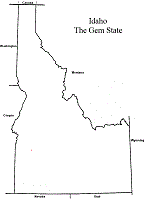This is a website for sharing historical and genealogical information about the state of Idaho. I would be very happy to link to any website you have which deals with these subjects. Any topic is acceptable as long as it deals with Idaho's history or genealogy.
The American history and Genealogy Project (AHGP) is an unincorporated, not-for-profit network of independent sites devoted to History and Genealogy and covering North American Countries and Territories. For more information about our group, including how you can join us, please see our AHGP Volunteer Projects.
The first Europeans to enter what is now Idaho are believed to be Captain Meriwether Lewis and Captain William Lewis, enroute to the Pacific Ocean. Their expedition crossed the Continental Divide at Lemhi Pass in 1805. Finding the Salmon River to rough for passage, they eventually crossed the state by way of the Lolo Pass and the Clearwater River. (See Discovering Lewis & Clark, Lewis & Clark at Nat'l Park Service and Trailblazers)
"For a half-century after the Lewis and Clark expedition the onward movement of events in Idaho is the story of the operations of fur companies." - cont., Fur Traders
In 1836 Henry H. Spaulding and his wife established a Nez Perce Indian mission near Lapwai (now Nez Perce County). Eliza Spaulding and Narcissa Whitman were the first European women to cross the Continental Divide.
In 1843 the first Oregon Trail immigrants passed through southern Idaho. (See Oregon-California Trails Assoc. and Oregon Trail at Nat'l Park Service.)
Idaho Territory was created on July 4, 1863, at Lewiston. Parts of the present-day state were included in the Oregon, Washington, and Dakota Territories. The new territory included present-day Idaho, Montana, and most of Wyoming. Idaho became the 43rd state on July 3, 1890.
County Index State History Index

click to enlarge
|
|||
| search engine by freefind |
Updated 9 November 2024 ~ Updates
Broken Links? Suggestions? Want to get involved? contact Sharon McConnel, Administrator
Happy Researching!

Webspace for this site is generously provided by Genealogy Village and Access Genealogy
Copyright © 2013 - Sharon McConnel. All Rights Reserved.
